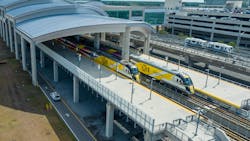FRA awards more than $1.2 billion in funding through two grants
The Federal Railroad Administration (FRA) has awarded more than $1.2 billion in funding through two different grant programs.
Railroad Crossing Elimination Grant Program
FRA awarded more than 1.1 billion in funding through the Railroad Crossing Elimination Grant Program to 123 rail projects, improving or studying more than 1,000 highway-rail crossings across the U.S. The funding is the largest single investment in grade crossing safety in FRA’s history. Combined with previous rail investments announced under the Biden-Harris Administration, FRA has now invested $48.5 billion in Infrastructure and Jobs Act (IIJA) funding in more than 445 rail projects across the country and Amtrak.
The grants will help communities in 41 states build railroad overpasses and underpasses, fund safety upgrades that will save lives and make improvements that will result in safer communities for pedestrians and motorists, as well as rail workers and riders.
“This Administration is tackling the issues that Americans face every day, and over the years, we have engaged with residents, community leaders and stakeholders across the country on the issue of grade crossing safety and blocked crossings,” said U.S. Department of Transportation Secretary Pete Buttigieg. “The Railroad Crossing Elimination Grant Program funding we’re announcing today is a sweeping effort that directly supports cities, towns and villages in every region of the country in their efforts to protect lives, prevent drivers being delayed by blocked crossings and improve the overall quality of life for their citizens.”
FRA notes accidents at grade crossings are the second leading cause of rail-related deaths in the U.S., with more than 2,000 incidents and 200 fatalities occurring at grade crossings each year. FRA also says blockages resulting from slow moving or stalled trains at crossings cost time and resources for American families and may cut off access roads and delay first responders from reaching emergencies. During the past year, FRA received more than 26,000 complaints of blocked crossings through the agency’s Public Blocked Crossing Incident Reporter.
“From day one of the Biden-Harris Administration, we have committed ourselves to making rail safer for all Americas, and since President Biden signed the Bipartisan Infrastructure Law, we have made unprecedented investments to modernize and improve America’s rail networks,” said FRA Administrator Amit Bose. “Today’s grants are another example of the Biden-Harris Administration reversing a half-century of federal underinvestment in America's rail network and delivering for the American people, helping people in communities big and small get to and from their homes, schools, businesses and workplaces safely and without delays.”
Major projects funded by the Fiscal Year (FY) 2023-2024 Railroad Crossing Elimination Grant Program include:
- Arizona – Hualapai Tribal Diamond Creek Road Grade Separation Project ($23 million)- The proposed project was selected for final design and construction and includes activities to create a grade-separated overpass and install anti-intrusion fencing along the rail corridor within the traditional lands of the Hualapai in Peach Springs, Ariz., for the Hualapai Tribal Council. The project aligns with the selection criteria by resulting in one or more grade-separated crossings, as the project will construct a grade-separated overpass/bridge structure and install fencing to improve safety in an area with a history of accidents. The Hualapai Tribal Council and BNSF will contribute the 20 percent non-federal match.
- Illinois – Chicago Region Environmental and Transportation Efficiency Program (CREATE) Project GS1 ($43.1 million)- The proposed project was selected for final design, right-of way-acquisition and construction and includes activities to support grade crossing and bridge-related improvements in the Greater Chicago region as part of the CREATE Project. The project will improve infrastructure owned by the Belt Railroad of Chicago. The project aligns with the selection criteria of improving the mobility of people and goods and access to communities, as the project will reduce vehicle delay due to gate-down time, improve railroad crossing safety, promote mobility and connectivity and advance sustainability and resiliency within Chicago’s Clearing West neighborhood, the Village of Bedford Park and the Village of Summit. The Illinois Department of Transportation and the Belt Railway Company will contribute the 20 percent non-federal match.
- North Carolina (NC) – NC State University/NC Railroad Crossing Safety Training Program ($3 million)- The proposed project was selected for project planning and includes activities to establish the Rail Technical Assistance Program, a training and education initiative aimed at improving safety and reducing accidents at highway-rail grade crossings. The project will educate the public and workers about rail crossing risks, promote safety practices to reduce accidents and injuries and provide localized training for those involved with rail crossings. The project aligns with the selection criteria by enhancing safety, as the project will educate railway workers, contractors, first responders, citizens, municipal and state employees, business owners and others. The NC Railroad Company will contribute the 20 percent non-federal match.
Restoration and Enhancement Grant Program
FRA has also awarded $146 million in funding through the Restoration and Enhancement Grant Program, bolstered by the IIJA to strengthen intercity passenger rail service on six routes across the country, helping to position newly initiated, restored and enhanced passenger rail routes for long-term success.
Major projects awarded funding includes:
- Connecticut’s CTrail Hartford Line service from New Haven, Conn., to Springfield, Mass. ($11.6 million)
- Amtrak’s Gulf Coast service from New Orleans, La., to Mobile, Ala. ($21.1 million)
- NC’s Amtrak Piedmont service from Charlotte to Raleigh, N.C. ($14 million)
- Amtrak’s Borealis service from Chicago to Minneapolis-St. Paul, Minn. ($38.6 million)
- Brightline’s Florida service from Miami to Orlando, Fla. ($33.8 million)
- California’s Amtrak Pacific Surfliner service on the Los Angeles – San Diego – San Luis Obispo Corridor from Los Angeles to San Diego. ($27.1 million)
The funding for Brightline’s Florida service will help the agency expand its trains from five to seven coaches, reducing capacity limitations within ongoing service and operations. The project will help meet the urgent need to increase passenger capacity on intercity passenger rail service from Miami and West Palm Beach, Fla. The funding is provided over a two-year period.
“Brightline has revolutionized how people travel around South Florida and proven that daily commuters need more options that make it possible for them to get out of their car,” said President of Brightline Florida Patrick Goddard. “The funding allows us to expedite new passenger cars into service and with that capacity, increased availability for the South Florida traveler.”
Brightline says the new commuter may be seen as a bridge or interim plan before the agency and local counties are able to establish commuter lines in Miami-Dade, Broward and Palm Beach Counties. Miami-Dade and Broward counties continue to advance projects to provide commuter service along the Florida East Coast corridor and discussions to finalize an agreement are ongoing.
“We’ve been working on developing a true commuter system in South Florida for years, but that solution takes time and can’t be turned on overnight. This is the next best thing and can be seen as an interim commuter program before Miami Dade and Broward launch service,” Goddard said.
In California, the funding for Amtrak’s Pacific Surfliner service will help fund the operation of three roundtrips between Los Angeles and San Diego, increasing frequency to 13 daily Pacific Surfliner roundtrips along this segment and fully restoring service to levels that existed on the corridor prior to the COVID-19 pandemic. The award marks a significant milestone for the LOSSAN Agency, as its first successful federal grant award.
"This grant award will enable the LOSSAN Rail Corridor Agency to restore and enhance Pacific Surfliner rail service along this vital corridor, which will benefit a wide range of local communities," said LOSSAN Agency Vice Chair and City of Fullerton Mayor Fred Jung. "Increasing service levels significantly improves transportation options for residents, students and visitors along the corridor, making train travel easier and more convenient."
The 351-mile LOSSAN Rail Corridor travels through a six-county coastal region in Southern California. It is the second busiest intercity passenger rail corridor in the U.S. and the country's busiest state-supported Amtrak route. LOSSAN notes ridership on the Pacific Surfliner, which serves 29 stations throughout the corridor, increased 20 percent in 2024 to more than two million. According to the LOSSAN, the strong ridership comes as the Pacific Surfliner is currently operating with 16 percent less service than in 2019. The grant funding supports operational costs for the restoration of service levels for up to six years.
"The LOSSAN Rail Corridor is one of the busiest routes in the country, servicing millions of travelers and connecting the entire Southern California coastal region," said U.S. Sen. Alex Padilla (D-CA). "This federal funding restores service to pre-pandemic levels. Thanks to the Bipartisan Infrastructure Law, we're providing more efficient, reliable and sustainable transportation options for all users along the LOSSAN Rail Corridor."
LOSSAN notes the restoration of the roundtrips between Los Angeles and San Diego will help fill gaps in the Pacific Surfliner's current schedule and move the schedule toward more consistent hourly train service. The 11th and 12th roundtrips are planned to be implemented in March 2025, with the 13th coming in November 2025.
"Every year, the Amtrak Pacific Surfliner train connects millions of people across our region. Whether it's helping to get fans to Padres games or visit local businesses and beaches, the train is a critical part of our communities," said U.S. Rep. Mike Levin (D-CA-49). "I'm glad I was able to help secure over $27 million in federal funding to increase the frequency of trains, helping us return to pre-pandemic service levels. With more trains, we'll have more travel options and less crowding. I'm excited to see all the ways our region will benefit from these federal resources."
According to LOSSAN, the Restoration and Enhancement Grant Program specifically funds the restoration of the roundtrips between Los Angeles and San Diego and supports further enhancements of rail service between San Diego and Santa Barbara and San Diego and San Luis Obispo. Additional roundtrips are planned for those segments in 2026 and beyond, pending equipment availability and future state funding allocations.
"Together, the train service restoration and enhancements will provide more consistent and reliable train service throughout the entire coastal corridor," Jung said. "The increase will help meet the growing demand for intercity passenger rail travel in the region and alleviate current overcrowding issues by offering more frequent and reliable rail options."
The full list of FY 2023-2024 Railroad Crossing Elimination Grant Program selections, as well as the full list of FY 2021-2024 Restoration and Enhancement Grant Program selections can be found on FRA’s website.
About the Author
Brandon Lewis
Associate Editor
Brandon Lewis is a recent graduate of Kent State University with a bachelor’s degree in journalism. Lewis is a former freelance editorial assistant at Vehicle Service Pros in Endeavor Business Media’s Vehicle Repair Group. Lewis brings his knowledge of web managing, copyediting and SEO practices to Mass Transit Magazine as an associate editor. He is also a co-host of the Infrastructure Technology Podcast.

